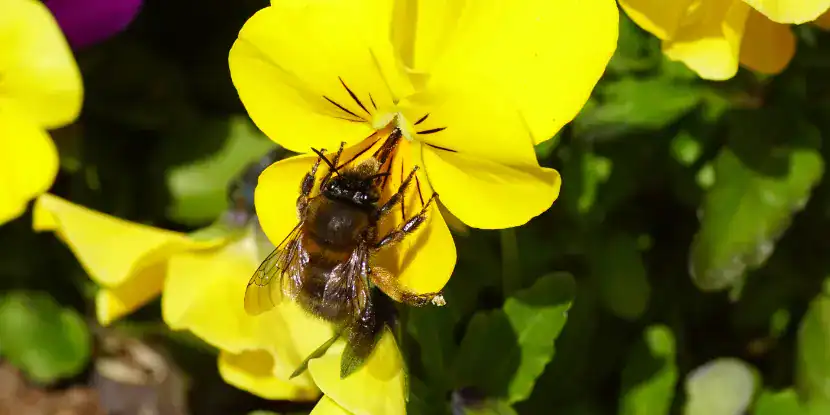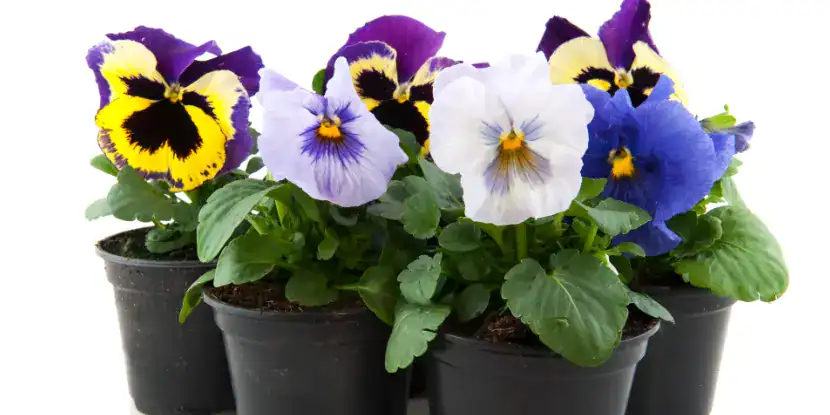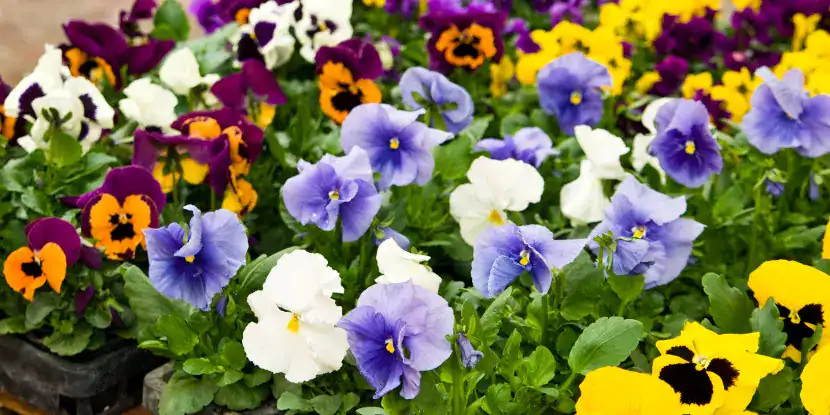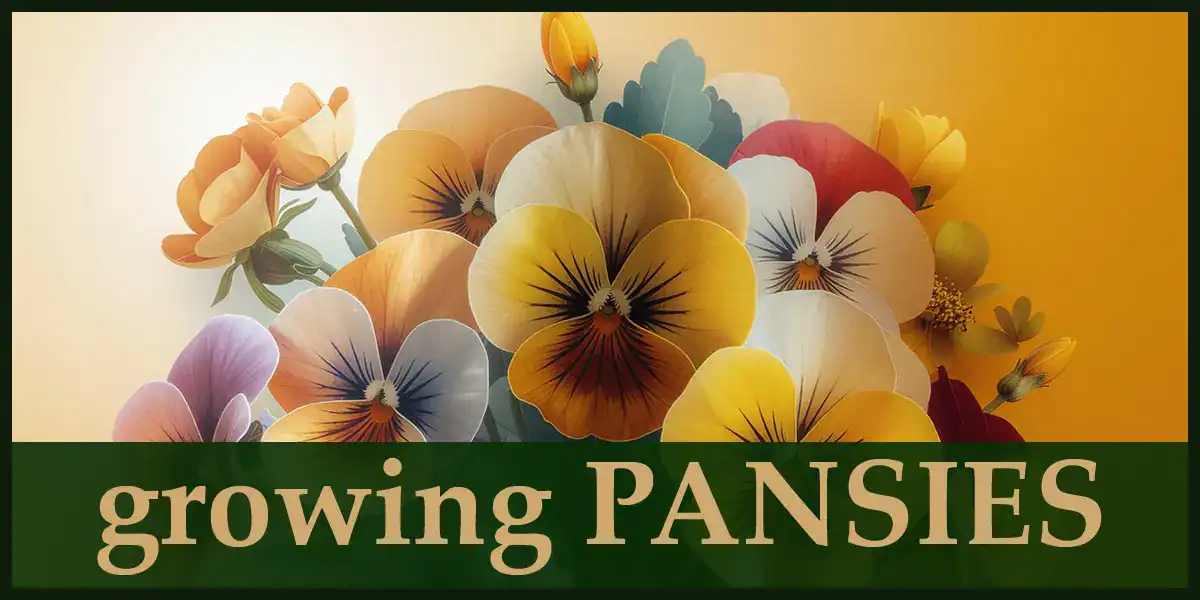“Pansy” comes from the French pensée, meaning “thought.” In Victorian floriography, pansies symbolized loving remembrance.
Their distinctive “faces” are guides for pollinators like bees, directing insects to the center of the flower and increasing the plant’s chances of pollination.
And their flowers are edible! These have a mild, slightly grassy flavor, sometimes with a hint of wintergreen or mint, and are often used in salads, desserts, and teas.
So imagine that — a thinking flower with a face that bees love, and you can enjoy in your hot beverage! What’s stopping you from planting pansies today?
Origins of the Flower
Pansies trace to 19th-century Europe. Bred from wild violets (Viola tricolor), these garden staples were developed for their unique “faces” and bold color patterns. Over time, hybridization produced the wide variety of sizes and hues we see today.
Pansies are short-lived perennials, often treated as annuals. Southern California gardeners often replant pansies each fall or winter, since intense summer heat can shorten their lifespan.
SoCal’s milder coastal climates allow pansies to bloom nearly year-round, and with proper care, they can act as stunning centerpieces for cool-weather gardens.

A pansy’s face directs pollinators to the flower’s center. Otherwise, they’d be lost!
Pansy Varieties to Consider
- Delta Pansies bear large blooms and are tolerant of temperature fluctuations.
- Frizzle Sizzle Pansies are distinguished by their deeply ruffled or crinkled petals.
- Cool Wave Pansies are a trailing variety tailor-made for hanging baskets or ground cover.
- Mammoth Pansies boast extra-large, showy flowers, sometimes 3 inches across.
Optimal Growing Conditions
Light
- Pansies prefer full sun to partial shade.
- Aim for at least 6 hours of sunlight daily, but provide afternoon shade in hotter regions of Southern California to prevent wilting.
Temperature
- Pansies perform best in cooler temperatures, thriving between 45°F and 65°F.
- While they tolerate light frost, extreme heat can stress the plants and stunt growth.

The ruffled “petticoat” petals and striking markings of Frizzle Sizzle Pansies.
Soil
- Soil should be well-draining and nutrient-rich.
- Aim for a pH of 6.0 to 6.2.
- Amend with compost for better structure and nutrition.
Steps for Planting Pansies from Seeds
- Plant seeds indoors 8–10 weeks before your desired transplant date.
- Use small seed-starting trays filled with lightweight, well-draining soil.
- Sow seeds 1/8 inch deep and cover lightly with soil. Don’t bury them too deep — pansy seeds need light to germinate.
- Mist the soil lightly, then cover the tray with plastic wrap to maintain humidity.
- Place the tray somewhere with indirect light and maintain temperatures around 65°F.
- Once seedlings develop 2–3 sets of true leaves, transplant them into your garden or containers, spacing them 6–8 inches apart.
Growing Pansies in Containers
- Choose a container at least 6 inches deep with drainage holes.
- Fill the container with a well-draining potting mix enriched with organic matter.
- Plant the pansy seedlings or seeds about 6 inches apart to give them room to grow and spread.
- After planting, water the soil thoroughly. Ensure the soil remains slightly moist but not waterlogged.
- Position the container in a spot that receives at least 4–6 hours of sunlight daily, such as a sunny patio or balcony.
- Pansies usually germinate within 10–14 days.

Pansies grow just as well in containers as in the yard, and can be protected from extreme heat.
Caring for Pansies
Water
- Keep the soil consistently moist but avoid overwatering. Pansies are susceptible to root rot.
- Water early in the morning to allow the foliage to dry and reduce the risk of fungal disease.
Fertilizer
- Feed pansies with a balanced fertilizer (i.e., 10-10-10) every 2–3 weeks to promote blooming.
- Over-fertilizing can lead to lush foliage but fewer flowers.
Pests & Diseases
Common pests include aphids, slugs, and snails.
- Apply neem oil sprays for aphids or whiteflies.
- Try natural deterrents like diatomaceous earth to discourage slugs.
For diseases like powdery mildew or root rot, ensure proper air circulation and avoid overwatering.

Pansies have various colors, markings, petal formations, and sizes.
Deadheading
Deadheading (removing spent flowers) promotes continuous blooming. Pinch off the wilted flower heads at the base of the stem
Pruning
- As pansies can become leggy, prune back in early summer to promote denser growth.
- Cut back any dead or damaged stems throughout the growing season.
Propagation
Pansy seeds can be collected and stored for planting next year.
- Allow some flowers to dry on the plant and collect seeds once they have turned black.
- Store in a cool, dry place until ready to sow in late winter or early spring.
- Alternatively, propagate by taking cuttings from healthy plants and rooting them in soil or water.
Companion Plants
Companion planting involves pairing different plants to enhance growth, deter pests, and create a harmonious garden environment.
- Combine with ornamental kale or cabbage for a winter garden aesthetic.
- Plant alongside snapdragons or violas for complementary color and texture.
- Grow with marigolds, nasturtiums, or aromatic herbs like lavender or rosemary to repel pests.

Some pansies have clear “face” markings. This one looks grumpy.
FAQs: Growing Pansies
Q: Can pansies tolerate frost?
Pansies can survive light freezes, making them ideal for cool-weather gardening.
Q: How long do pansies bloom?
With proper care, pansies can bloom continuously for up to 6 months in cooler climates.
Q: Can pansies grow indoors?
Yes, if provided with enough light and consistent care.
Q: Why are my pansies turning yellow?
Yellowing leaves are often a sign of overwatering or nutrient deficiencies. Adjust watering and fertilization to resolve the issue.
Q: How often should I water pansies?
Water pansies 1–2 times per week, adjusting based on weather conditions.
Q: When is the best time to plant pansies in Southern California?
Late fall to early winter is ideal, as pansies thrive in cooler temperatures.
Q: Are pansies safe for pets?
Pansies are non-toxic to pets, so they’re a safe addition to dog- and cat-friendly yards.

